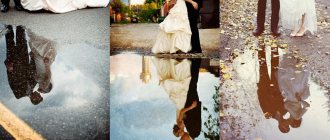In this tutorial we will work on editing a wedding photo. Today we will focus on working with Smart Objects . Agree that works created without the use of smart objects are no different visually from works created using smart objects. However, I think this lesson will show you a lot of new and useful things; perhaps the techniques shown will be new to some!
Resources for Further Study
The ABCs of Photo Sorting: How to Turn a Stash of Photos into an Organized Collection : Have you ever found yourself in a situation where an important project feels overwhelming and you have no idea where to start? You put it off, don’t start it, and after a while it becomes a mental anchor, forever placed on your to-do list.
No Light, Low Light, No Problem: Night Portrait Photography : Photography is dependent on light, but can you take pictures if there is no light?
How to Create a Compelling Photo Story with Exposure : Exposure is an increasingly popular online platform for publishing photo essays and long-form narratives—stories that are told using a combination of photos and text. In this tutorial you will learn how to create an amazing photo essay using this service.
Inspiration
Newlyweds on the beach
Photo: Photodune
Although it is obvious that this photo is staged, the young people look very happy and relaxed. Lighting and composition are great for creating a nice, atmospheric photo.
Kiss
Photo: Photodune
A traditional kiss shot will always turn out great, but this one uses a low angle shot, the surrounding environment, golden highlights and purple tones add even more drama. The bride's bouquet works as a small bright element that attracts the eye to the newlyweds.
Carefree
Photo: Photodune
A brick wall and a small element decorated with metal ornaments are the perfect backdrop for a photo. I also love the look on the groom's face. I think the photo is a little flat, but if you soften the tones a little, you get a classic, timeless style.
Silhouettes
Photo: Photodune
You don't have to photograph the newlyweds the traditional way to get amazing results. These silhouettes against the sunset with grass in the foreground also look incredible.
Make a collage
Photo: Photodune
All the little details that you captured throughout the day are perfect for a collage like this. A photo of cufflinks or flowers may not look very good on its own, but when you combine them, you'll get a great story and the collage will also look great in a printed version.
How to speed up the process of selecting wedding photos?
11. First, all photos from flash drives need to be copied to your hard drive. Make sure the photos are copied and clean the flash drives. Otherwise, tomorrow you will come to the wedding with flash drives filled to capacity - and you will have to format them chaotically.
12. Use programs for cataloging and ranking photographs to view and select footage. If you first look through the entire series of 2000-3000 photos for marriage, and then to divide them into folders, and then for detailed retouching, you will need to scroll through them at least 3 times. To do all this in one viewing, use programs with a rating system (Adobe Bridge, Adobe Lightroom, etc.).
- Defective frames (shaky frames, blatant overexposure, missed focus, etc.) should be deleted immediately.
- Remove duplicates, choosing the most natural and emotional frame from the series.
- For example, mark portfolio shots for artistic processing and detailed retouching with five stars.
- For the rest of the pictures that will only need light and color correction, give four stars.
- Mark frames that you are unsure about with three stars.
- Mark shots by location and light conditions with appropriate colored markers (yellow near the window, green under the oak tree, etc.).
13. Select 3-5 best frames from those marked with five stars, immediately process them and send them to the newlyweds in a day or two, so that they can post beautiful frames of their wedding on their page on social networks. Efficiency is now highly valued, so be on trend and take care of your customers.
How to organize the transfer of photos to the newlyweds?
24. You can collect 3-5 weddings, write the photos onto flash drives, put the printed photos into boxes, add flash drives, photo books, business cards and accessories, and then send them to all customers by courier service. This saves a lot of time.
25. You don’t have to wait until you process a bunch of weddings, but hand over the photos to the couple personally as soon as they are ready. It will take more time, but sharing photos in person will give you the opportunity to reconnect with your subjects, see clients' genuine reactions to your work, and strengthen your partnership. Here it’s up to you to decide whether to save time at this stage or not.
Photo: Sergey Arinokhin
What you need
Suitable Lens
Everyday universal lenses are not suitable for wedding photography. You'll need at least one fast lens that also performs well in low light conditions. Churches and halls are often very dark and the use of flash is prohibited.
Fixed focal length lenses are usually the best: they work quickly and produce clear images. In addition, they can be purchased at an affordable price. Most photographers have fifty dollars in their arsenal, the f/1.8 version of which costs about $120.
A wide-angle lens is essential for group photos. However, make sure that no one is standing close to the edge of the frame otherwise they will look distorted.
A lens with a good zoom is ideal for discreetly capturing moments of sincere communication or expression of feelings. If you approach someone with a camera, they won't be able to behave naturally and will go into "I'm posing for a photo" mode. By being at a distance and using a zoom lens, you'll have a better chance of capturing people in their truest emotions and will get lots of cute shots.
Flash
Even though you won't be able to use the flash in some places, it will definitely come in handy for the evening. When the lights go down and the dance floor lights come on, filming becomes more difficult. Use walls as a diffuser to soften the light, and avoid pointing the flash directly at guests if possible.
Route
Don't even try to work a wedding without first researching the places you're visiting. A preliminary assessment will help you spot problem (usually dark) areas, as well as places for formal, staged shots. You will be able to mark alternative indoor locations in case the weather is bad.
You also need to know how long it takes to get to each point. This will allow you to plan your time and avoid delays. Mark the parking lots for yourself and find out if there will be free spaces there. Are there any alternatives if the parking lot is full? Do I need to pay or get a permit?
You also need to know in what part of the day each stage of the wedding will take place, so that you can always be in the right place and know what you will have to do during each stage.
Post-processing skills
Your shots can look completely different as you move between different locations or as lighting conditions change throughout the day. After shooting, you need to create harmony between all the pictures so that they look better in an album or composition.
Actions (or presets) for Adobe Photoshop and Lightroom can not only improve the appearance of your photos, but also save a lot of time. You can even save your processing as an action, and then run it for each shot.
Insurance
In any professional photography job, you should be provided with insurance. However, I have heard many people being asked to photograph a friend's or relative's wedding very cheaply or just for the experience without mentioning insurance. It is a bad idea. Even if you know for sure that the bride and groom will not sue, if some trouble happens, you cannot be sure that one of the guests will not do this.
If you drop a camera on your child's head and the parents want to sue, you will have to pay all the costs or fines/compensations yourself. If you break something in the house while swinging a tripod, you will be responsible for it. Don't neglect insurance.
Contract
This is a very important and large part of the preparation. The contract should state exactly what you must do, for how much money, and under what conditions. Ideally, you should also negotiate and take an advance payment.
Make sure the client reads and understands the contract and signs and dates each page.











